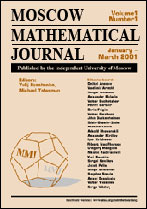|
This article is cited in 5 scientific papers (total in 5 papers)
Moduli of Tango structures and dormant Miura opers
Yasuhiro Wakabayashi
Department of Mathematics, Tokyo Institute of Technology, 2-12-1 Ookayama, Meguro-ku, Tokyo 152-8551, Japan
Abstract:
The purpose of the present paper is to develop the theory of (pre-)Tango structures and (dormant generic) Miura $\mathfrak{g}$-opers (for a semisimple Lie algebra $\mathfrak{g}$) defined on pointed stable curves in positive characteristic. A (pre-)Tango structure is a certain line bundle of an algebraic curve in positive characteristic which gives some pathological (relative to zero characteristic) phenomena. In the present paper, we construct the moduli spaces of (pre-)Tango structures and (dormant generic) Miura $\mathfrak{g}$-opers respectively and prove certain properties of them. One of the main results of the present paper states that there exists a bijective correspondence between the (pre-)Tango structures (of prescribed monodromies) and the dormant generic Miura $\mathfrak{s} \mathfrak{l}_2$-opers (of prescribed exponents). By using this correspondence, we achieve a detailed understanding of the moduli stack of (pre-)Tango structures. As an application, we construct a family of algebraic surfaces in positive characteristic parametrized by a higher dimensional base space whose fibers are pairwise non-isomorphic and violate the Kodaira vanishing theorem.
Key words and phrases:
oper, dormant oper, Miura oper, Miura transformation, Tango structure, Raynaud surface, pathology, $p$-curvature.
Citation:
Yasuhiro Wakabayashi, “Moduli of Tango structures and dormant Miura opers”, Mosc. Math. J., 20:3 (2020), 575–636
Linking options:
https://www.mathnet.ru/eng/mmj778 https://www.mathnet.ru/eng/mmj/v20/i3/p575
|

| Statistics & downloads: |
| Abstract page: | 152 | | References: | 25 |
|




 Contact us:
Contact us: Terms of Use
Terms of Use
 Registration to the website
Registration to the website Logotypes
Logotypes







 Citation in format
Citation in format 
